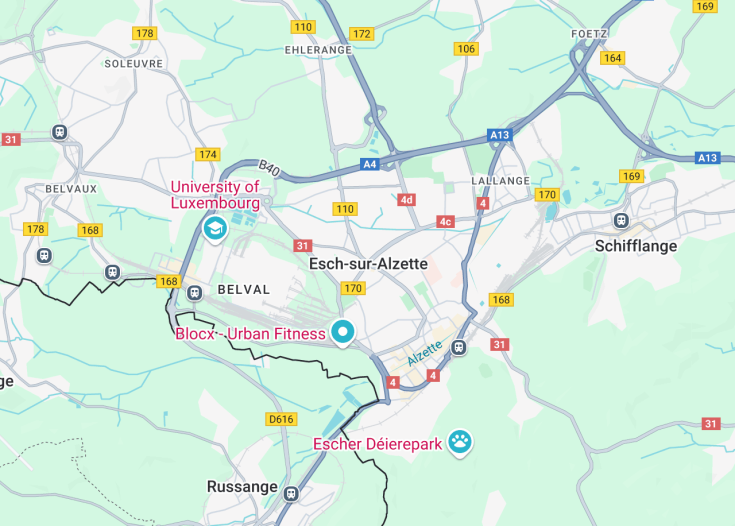Esch-sur-Alzette, Luxembourg’s second-largest city, serves as the heart of the country’s iron and steel industry. It boasts a rich industrial heritage and vibrant cultural scene. Noted for its educational institutions like the University of Luxembourg’s Belval Campus, the city intertwakes innovation with historical preservation. Offering diverse architectural sights, from the modern Belval to traditional European boulevards, Esch-sur-Alzette provides a unique glimpse into Luxembourg’s dynamic growth and multiculturalism, making it an intriguing destination for any traveler.
Explore the gaalgebierg park, a perfect spot for relaxation and enjoying nature, adding a refreshing escape within the urban landscape of Esch-sur-Alzette.
Don’t miss a visit to ‘Rockhal’, Luxembourg’s premier concert venue hosting international music acts and cultural events.
Top things to do & see in Esch-sur-Alzette
Select the following sights and activities to discover best tickets and tours available in Esch-sur-Alzette.
Esch-sur-Alzette: The Heart of the Minett Region
| Country | Luxembourg |
| Time in Esch-sur-Alzette | GMT+2 |
| Language spoken | Luxembourgish |
| Population | 35,040 (Statista, 2022) |
| Currency | Euro (€, EUR) |
| Airports |
|
A charming city in southern Luxembourg, Esch-sur-Alzette is the second-largest city in the country and serves as the vibrant heart of the Minett region. Known for its rich history in iron and steel production, the city has transformed into a cultural hub. With numerous theaters, cultural festivals, and universities, it is a prime example of industrial heritage morphing into modern vitality.
Where is Esch-sur-Alzette?
Esch-sur-Alzette is located in the southern part of Luxembourg, near the French border, surrounded by lush forests and industrial landscapes.
Distances:
| Route | Distance by car | Time by car |
|---|---|---|
| Luxembourg City to Esch-sur-Alzette | 19 miles (30 km) | 30 minutes |
| Thionville to Esch-sur-Alzette | 15 miles (24 km) | 25 minutes |
What is Esch-sur-Alzette famous for?
Esch-sur-Alzette is widely recognized for its historical significance in steel production. The city is also known for hosting the vibrant ‘Esch2022’, a part of the European Capital of Culture program, showcasing vibrant cultural diversity and artistic innovation.
History
Prehistoric to Medieval Times (Before 15th Century)
Esch-sur-Alzette, often referred to simply as Esch, boasts a rich and layered history that dates back to prehistoric times. Archaeological evidence, such as tools and pottery, suggests early human activity in the area, but it wasn’t until the Roman period that significant settlements began to emerge. The region saw various governance changes through the Middle Ages, marked by agricultural development and feudal systems dominating the landscape. Various noble families controlled the area, utilizing its natural resources and strategic position.
Industrialization (19th Century – 20th Century)
The real transformation of Esch began in the 19th century with the discovery of iron ore in the surrounding region, ushering in a period of rapid industrialization. By the late 1800s, Esch-sur-Alzette was a booming mining town, attracting workers from Italy, Portugal, and other European countries, which profoundly influenced its cultural landscape. The steel industry became the backbone of the city’s economy, contributing significantly to Luxembourg’s overall economic growth. The development of rail connections and industrial infrastructures further boosted the local economy, firmly establishing Esch as a key industrial hub.
Post-Industrial Era to Present Day (Late 20th Century – 21st Century)
The decline of the steel industry in the late 20th century forced Esch to reinvent itself. Efforts were made towards developing service industries and IT, along with a focus on education and culture. The University of Luxembourg has a significant presence in the city, bringing a youthful vibrance and fostering innovation. Today, Esch-sur-Alzette enjoys a dynamic multicultural atmosphere, with ongoing projects intended to enhance its cultural offerings and economic resilience. The city’s industrial past is still evident in its architecture and several preserved sites, now part of its cultural heritage.
Visit Esch-sur-Alzette
What to see and do in Esch-sur-Alzette
Esch-sur-Alzette, the second largest city in Luxembourg, offers visitors a blend of cultural and historical experiences. Discover its industrial heritage at the National Museum of the Resistance, which provides insights into Luxembourg’s WWII efforts and the impact of the mining industry. Stroll through the city’s lush parks, such as Gaalgebierg Park, perfect for a peaceful walk or a picnic. For the art enthusiasts, Kulturfabrik, a cultural center set in a former slaughterhouse, hosts concerts, exhibitions, and workshops. Don’t miss the Belval Plaza, where the old steelworks have been transformed into a bustling district with shops, offices, and educational facilities.
- National Museum of the Resistance
- Gaalgebierg Park
- Kulturfabrik cultural center
- Belval Plaza
Festivals and Events
Esch-sur-Alzette is alive with events throughout the year. Celebrate music and culture at the ‘Rockhal’ which features international music acts. In summer, don’t miss the ‘Esch Street Festival’, a lively event with street performances, food stalls, and crafts. The ‘Escher Kulturlaf’, a popular race in September, combines sports with cultural entertainment.
Best time to visit Esch-sur-Alzette
The best time to visit Esch-sur-Alzette is from late spring to early autumn, specifically May through September, when the weather is most pleasant and the city’s events are in full swing. This period offers an ideal climate for exploring the outdoors and participating in the numerous festivals.
Is Esch-sur-Alzette worth visiting?
Esch-sur-Alzette offers a unique mix of industrial heritage and vibrant cultural life that makes it a worthwhile visit. The transformation of its historical sites into contemporary cultural venues is particularly appealing. However, visitors looking for traditional tourist attractions like grand monuments may find it less exciting. The city is an excellent destination for those interested in the industrial history of Europe and contemporary culture. Its multicultural atmosphere and revival of old industrial sites provide a fascinating glimpse into the region’s past and future.










